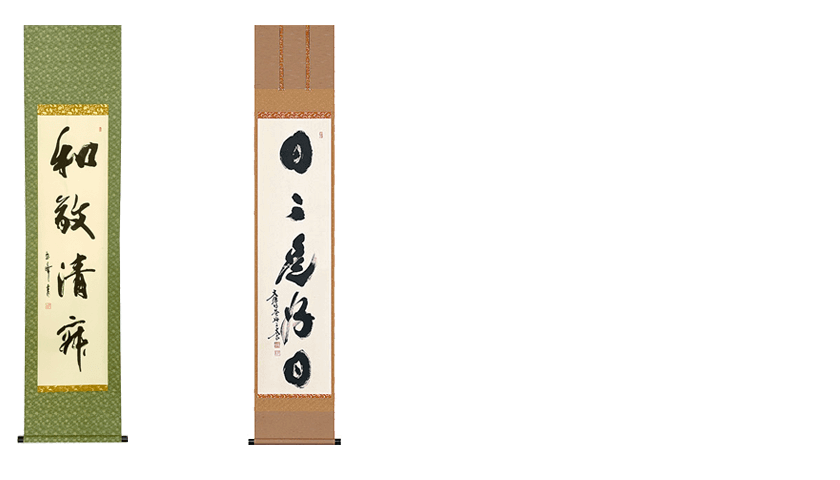Lesson
News / Blog
Other Menus
Usual Kakejiku

Type of Kakejiku that Doesn’t Choose Its Season
‘Usual–kakejiku, (aka jōjigake or jōgake) is a type of kakejiku which can be displayed regardless of the season. Since kakejiku of this kind is most frequently used among all types of hanging scroll, for the collectors it is recommended to obtain them as the first kakejiku.
Sansui / Landscape Painting
‘Landscape painting’ has been commonly called ‘sansui-ga’ in Japan and ‘landscape painting’ was meant to be ‘sansui-ga’ until around the Edo period.
‘Sansui-ga’ is a type of painting literally depicting ‘mountain’ and ‘water’. In these paintings presence of ‘water’ like, a river or a waterfall is drawn in harmony with mountains to portray the scenery of nature.
From ancient time, some mysterious being is believed to exist in Mother Nature in the east. In China, the hermit of Mother Nature, while in Japan, the Mighty God is thought to be lived or present in the nature and there are countless similar beliefs.
The idea of leaving from society someday to settle down somewhere in nature as an ideal destination infiltrated to people and consequently nature became a popular subject of painting and ‘sansui-ga’ grew to be favored by painters. It is said that in China, already quite a few ‘sansui-ga’ were drawn in the Tang dynasty.
Western painting was introduced in Japan in the Meiji period and because the paintings did not necessarily portray mountain or water, it was included in a larger genre ‘Landscape Painting’ and so was ‘Sansui-ga’.
Sansui-ga which is drawn only with sumi ink is called ‘suiboku-sansui’. Being in merely ink color which doesn’t look seasonal, it can be displayed regardless of the season. By contraries, Sansui-ga in color is called ‘saishiki-sansui’ which is basically also displayable for all seasons but a point to be noted is in case the seasonal motif was drawn there, it will be treated as ‘kisetsu-gake’ (seasonal kakejiku), the kakejiku which indicates the season. For instance, a sansui-ga portraying cherry blossoms will be a kisetsu-gake for spring and maples will be the kakejiku for autumn.
‘The scenery with temple’ is a popular motif for landscape painting as with sansui-ga and kakejikus with this motif are also displayable all the year round.
Places of interest representing Japan are other popular motif of landscape paintings such as Mt. Fuji, Kamikōchi or Taishō-ike Pond in Nagano prefecture and Oirase in Aomori prefecture.
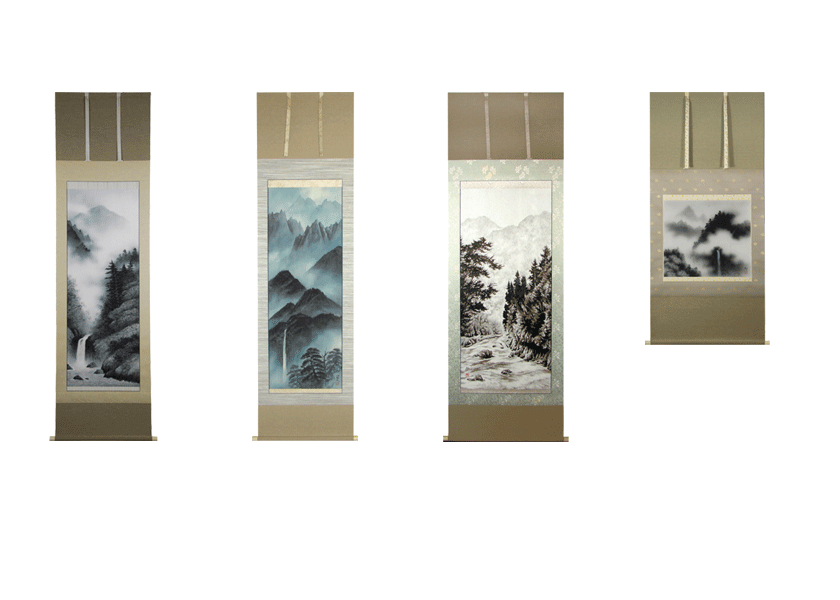
Shikibana / Four Flowers
Shikibana / Shikika is a motif with four flowers that symbolize four seasons and is also a favored subject of usual–kakejiku.
Certain flowers tend to be portrayed and a peony, considered as ‘the king of flowers’ in China, is drawn in the middle of an artwork representing summer and generally plum blossoms are portrayed symbolizing spring while Chinese bellflowers/chrysanthemums and the nandina’s red berries each represents autumn and winter. For the summer scheme, irises are occasionally added to the peony in the centre. (Somehow the morning glory is missed out as a motif.) As for the nandina for winter, its berries are portrayed instead of its flowers as most of flowers wilt during winter and furthermore, the berry is thought to be auspicious in Japan so it could explain why nandina’s berry was the one.
This motif ‘shikibana’ wasn’t frequently drawn long ago. We have been dealing with numerous old kakejikus yet hardly remember a kakejiku with the motif. Still there are artworks portraying various plants but regardless of seasons and aren’t arranged by four seasons particularly.
I assume the motif became favored at the high economic growth period. Demands of kakejiku leaped as a result of an unprecedented my own home boom during the period.
Presumably, during the craze the motif was produced through a groping for a brand new motif other than ‘sansui-ga’ the standard jōjigake at the time.
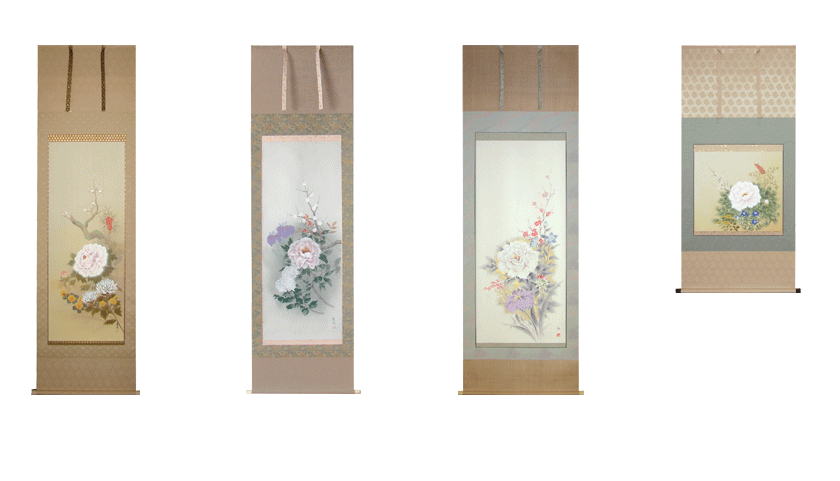
Shikunshi
‘Shikibana’ described above and one of the major motifs today has its origin called ‘shikunshi’.
Shikunshi means ‘the Four Noble Ones’ and ‘kunshi’ is the word for a virtuous and well-educated individual and as the four plants representing each kunshi greatly caught on as a motif, they have been portrayed in China since ancient time.
The four plants, ‘plum blossom, bamboo, orchid and chrysanthemum’ characterize each kunshi. As the plants represent the four different seasons, shikunshi which depicts all those plants collectively is also displayable through the year.
The following shows which characteristic of each plant describes the personal trait of each kunshi.
Orchid: For spring. Its graceful yet subtle aroma symbolizes the grace of kunshi.
Bamboo: For summer. Its upward growth indicates sincerity and vigor while its trait of being unbroken symbolizes power and tendency not to discolor signifies prosperity.
Chrysanthemum: For autumn. Its gorgeously colorful and vivid look in full broom represents the splendor of kunshi.
Plum blossom: for winter. Plum blossom represents spring on shikibana kakejikus whereas it is a symbol of winter on shikunshi ones. The plum tree is the first tree to blossom in spring after going through winter, the season when plants and flowers wilt and for that reason it is a motif for both winter and spring. Because of the trait, the plum tree is considered as a symbol of vitality.
This motif is said to be already around in the period of Sung Dynasty(960-1279) in China. Given that ink painting was introduced in Japan when Zen sect was promulgated from China, this motif of shikunshi assumingly also was brought around the Kamakura period (1185-1333) in Japan. I find it interesting to trace the past and know that the motif was reestablished as shikibana at the high economic growth period in Japan.

Take-ni-suzume / Bamboo and Sparrow
‘Bamboo and sparrow’ is a very popular motif in Japan which is a combination of icons believed to be auspicious from ancient time.
As I mentioned when describing shikunshi previously, the bamboo has been a familiar plant in Japan for its trait of growing upward and being unbroken which is believed to bring a good luck.
The sparrow has been also thought to be auspicious in Japan. According to folklore, white sparrows were used to be offered to the emperor. They are prolific birds and for this reason, the bird was considered to be good luck for being blessed with many offspring. Their natural habitat is next to human community to co-exist receiving the benefits from the neighbors and man-made objects and interestingly enough, they change their habitat following a movement of human habitation.
The bird which always lives close to human dwelling has been absolutely familiar to the residents. The animal or plant with this trait is called synanthrope. A characteristic of animal of this kind could relate to history of kakejiku and that intrigues me.
A pattern of an auspicious combination of bamboo and sparrow has been used in variety of situations since the old days in Japan. The pattern was regularly used as a crest of samurai families. For instance, the family crest of Uesugi family well known by Uesugi Kenshin as well as those of Date family famous for Date Masamune.
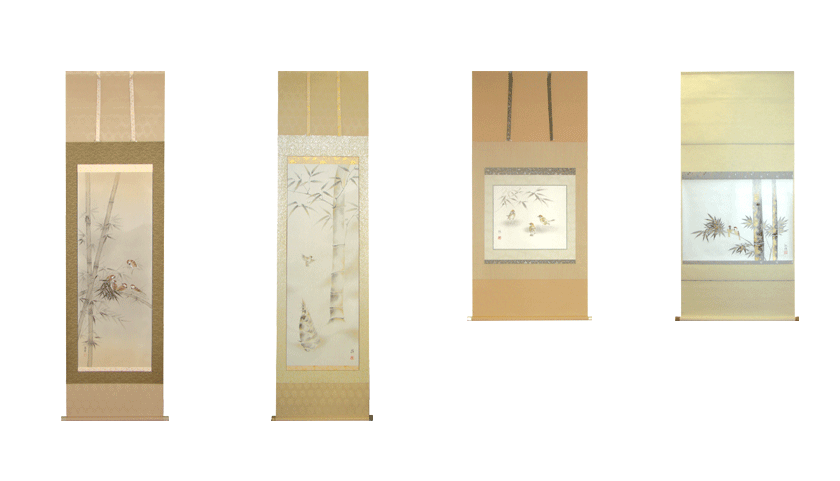
Fukurō / Owl
Japanese is the nation that loves rhyming, phonetic equivalent and pun. Something associated with good fortune is quite often originated from these three word games.
It is no exaggeration to say that ‘fukurō (owl)’ is the best example.
Fukurō is thought to bring happiness considering the meaning of following phonetic equivalents.
「福籠」 It means good fortune will be piled up in a basket.
「不苦労」 It means to live without hardship.
「福老」 It means to grow old happily.
「福来」 It means good fortune will come.
Furthermore, a feature of the bird, turning their head 360 degrees is thought to be auspicious as it suggests a prosperous business. – In Japan, ‘Money flows’ is expressed as ‘Head turns’.
Assumingly the owl motif became favored around the high economic growth period in the Showa era as well.
The owl is considered to be an auspicious bird not only at home but overseas. For example, in ancient times the bird symbolized Athena, the goddess of wisdom in Greek mythology.
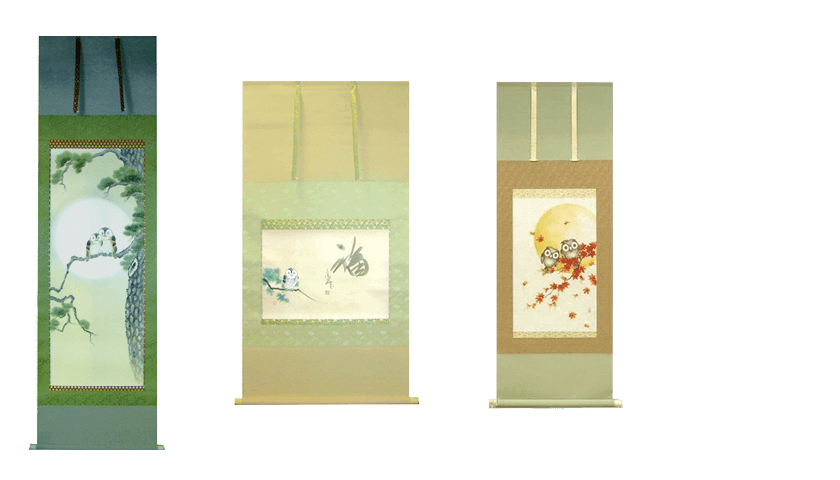
Dragon and Tiger
Both the dragon and the tiger are favored subject for jōjigake. They can be portrayed together and by itself. Both of the motifs are mainly used for a jōjigake due to their recognition as the guardian god who repels an evil power.
Besides, as they are powerful symbols the motifs can be seen in sekku-gake, the kakejiku displayed on the Boys’ Festival wishing boys a strong-mind as well as strong growth.
Both motifs have been drawn from old times and the dragon in particular was the favorite motif of Kanō School, the biggest school of painting in the Edo period.
Although since old days the tiger also has been an admired motif, as the animal does not exist in Japan, the imaginary figures inspired by large cats were drawn. The tiger portrayed by Maruyama Ōkyo also looks like a large cat.
Saeki Ganku in the Edo period is well-known as the first painter who portrayed a realistic tiger in Japan. He allegedly analyzed a look of the real tiger by fitting its coat on its skull which he has obtained.
In the Meiji period, more and more opportunities were available to see the tiger at a circus or an entertainment show. Ōhashi Suiseki is the painter who was internationally recognized by accurately depicting realistic tigers taking those opportunities.
It is not too much to say that you would see the influence of the touch of Ōhashi Suiseki in almost of all modern tiger drawings.
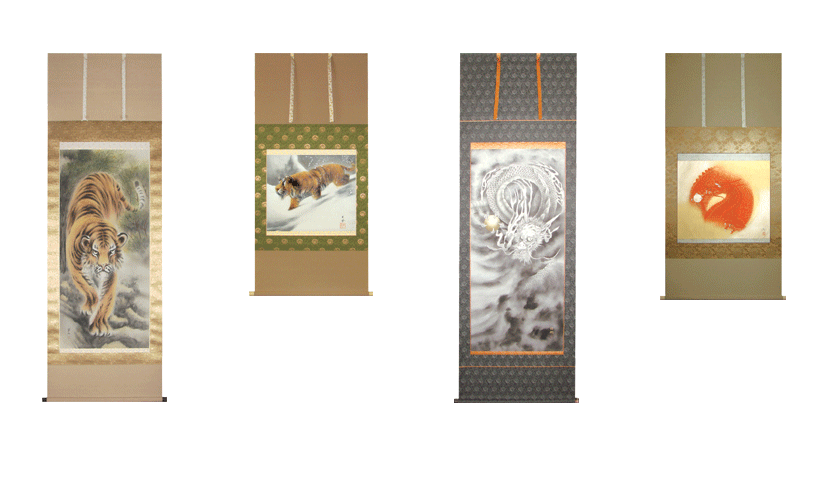
Calligraphy
Calligraphy chooses the season and event to be displayed depending on the content so I will introduce calligraphy kakejikus generally displayable in any season.
和敬清寂 / Wakeiseijaku
Wakeiseijaku is the principal in sadō (Japanese tea ceremony). It teaches the host and guests the importance of being peacefully respectful to each other, maintaining tea room equipments and ambience of tea ceremony clean and having a peace of mind.
日々是好日 / Nichinichi kore kōjitsu (Hibi kore kōjitsu)
‘Nichinichi kore kōjitsu’ is one of Zen terminologies literally means ‘every single day is wonderful’.
The terminology has been interpreted extendedly to ‘endeavor to have good every single days’ and even further, ‘it’s wrong to judge good or bad of your day and be glad and sad by turns in the first place as you should cherish this moment .’ or ‘accept and appreciate as it is.’
